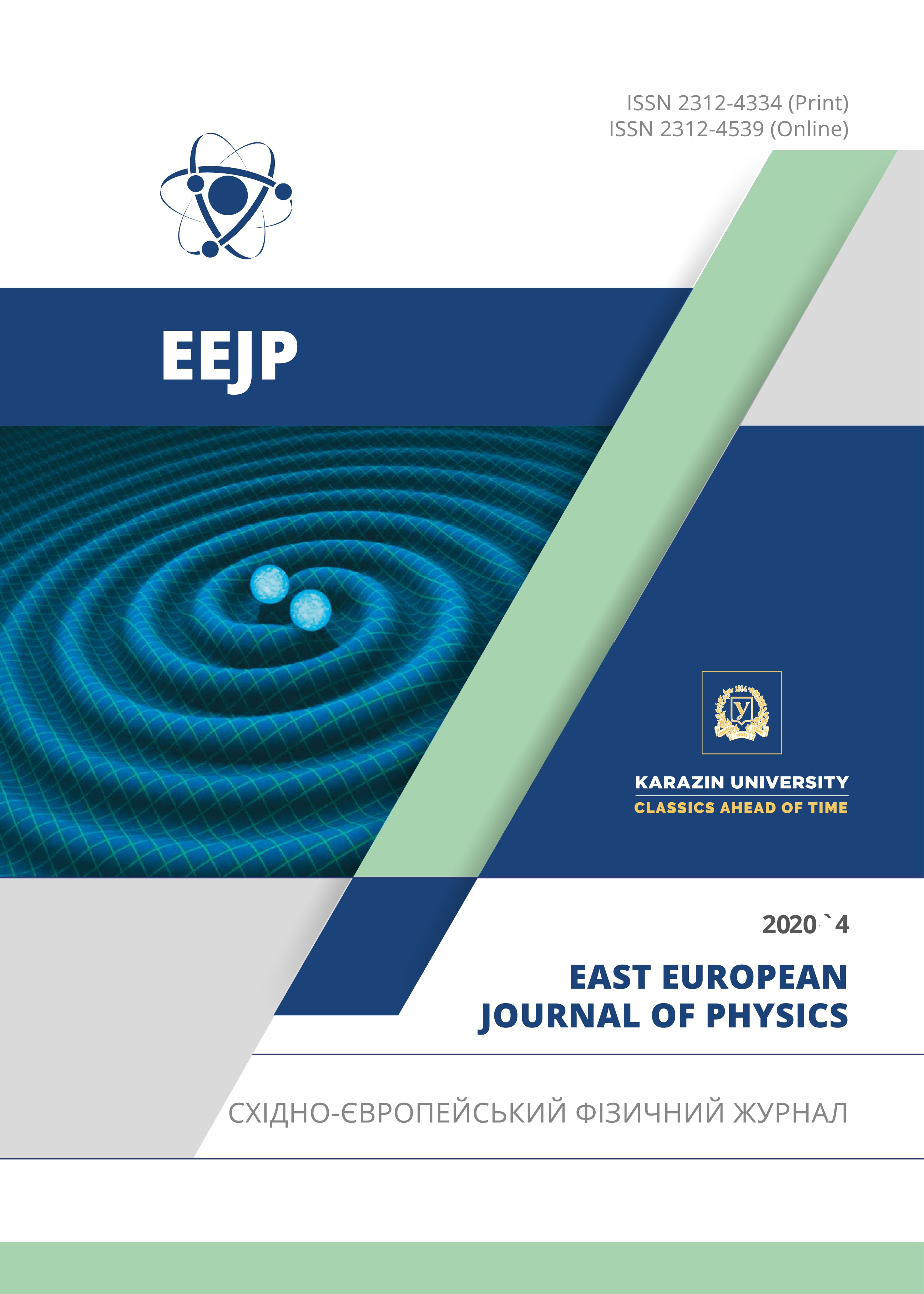Гідродинамічна Kelvin-Voigt модель транспортної системи
Анотація
Розглянуто гідродинамічна Kelvin-Voigt модель виробничих систем з потоковим методом організації виробництва. Визначено основні макропараметри стану виробничої лінії і взаємозв'язку між ними. Представлений аналіз основних характеристик моделей пружних елементів, які використані для аналізу виникнення динамічних напружень в рухомій конвеєрній стрічці. Сформульовано крайову задачу для пружних поздовжніх коливань в конвеєрній стрічці з рухомим матеріалом. Передбачається, що деформація елемента стрічки конвеєра відповідає Kelvin-Voigt моделі і ковзання рухомого матеріалу по стрічці відсутній. При визначенні сил опору руху, діючих на одиничний елемент стрічки, використані рекомендації DIN 22101: 2002-08. Проведено аналіз Kelvin-Voigt моделі пружного елемента і продемонстровані відмінні риси моделі. Дано обгрунтування вибору Kelvin-Voigt моделі пружного елемента для опису процесу виникнення пружних поздовжніх коливань в конвеєрній стрічці. Оцінена залежність нерівномірного надходження потоку матеріалу і величини напружень в стрічці. Записано вираз для швидкості розповсюдження збурень вздовж рухається конвеєрної стрічки з матеріалом. Визначено причини прискорення і гальмування конвеєрної стрічки, пов'язані з нерівномірним надходженням матеріалу на вхід транспортної системи. Продемонстровано зв'язок між швидкістю руху конвеєрної стрічки і масою матеріалу уздовж секції конвеєра. Показано, що збільшення потужності електродвигуна при старті і прискоренні конвеєрної стрічки, а також зменшення потужності при гальмуванні і зупинці конвеєрної стрічки є причиною виникнення в ній динамічних напружень. Аналізуються характерні фази початкового руху конвеєрної стрічки з матеріалом. Досліджено процес виникнення динамічних напружень з постійним і змінним прискоренням конвеєрної стрічки для фази розгону і гальмування конвеєрної стрічки. Для аналізу використана модель конвеєрної лінії в безрозмірному вигляді. Отримано вираз для статичних і динамічних напружень в конвеєрній стрічці. Оцінена амплітуда коливань динамічних напружень і характерний час загасання коливань в конвеєрній стрічці. Продемонстровано квадратична залежність швидкості загасання хвилі динамічних напружень зі збільшенням частоти коливання. Показана обернено пропорційна залежність характерного часу загасання виникли динамічних напружень від величини коефіцієнта в'язкості композиційного матеріалу конвеєрної стрічки
Завантаження
Посилання
O.M. Pihnastyi, and V.D. Khodusov, East European Journal of Physics, 1, 121-136 (2020), https://doi.org/10.26565/2312-4334-2020-1-11.
O.M. Pihnastyi, and V.D. Khodusov, Bulletin of the South Ural State University. Ser. Mathematical Modelling, Programming & Computer Software (Bulletin SUSUMMCS), 10, 67-77 (2017), https://doi.org/10.14529/mmp170407.
O.M. Pihnastyi, Scientific bulletin of National Mining University, 4, 104–111 (2017), http://nbuv.gov.ua/UJRN/Nvngu_2017_4_18.
DIN 22101:2002-08. Continous conveyors. Belt conveyors for loose bulk materials. Basics for calculation and dimensioning. [Normenausschuss Bergbau (FABERG), DIN Deutsches Institut für Normung e.v. Normenausschuss Maschinenbau (NAM)], (2002), pp.51.
Ju. Razumnyj, A. Ruhlov, and A. Kozar, Mining Electromechanics and Automation, 76, 24–28 (2006). https://docplayer.ru/64655888-Povyshenie-energoeffektivnosti-konveyernogo-transporta-ugolnyh-shaht.html
M. Alspaugh, in: MINExpo-2004, (New York,Las Vegas, NV, USA, 2004), pp. 17-27 (2004), http://fliphtml5.com/pfyf/pccg/basic.
SIMINE for conveyors. Siemens. (2020), https://new.siemens.com/global/en/markets/mining-industry/transport/conveyor-systems.html
R. Pascual, V. Meruane, and G. Barrientos, in: XXVI Iberian Latin-American Congress on Computational Methods in Engineering (CILAMCE-2005, Santo, Brazil, 19th–21st October 2005), Paper CIL0620, (2005), pp. 1–15, http://citeseerx.ist.psu.edu/viewdoc/download?doi=10.1.1.494.34&rep=rep1&type=pdf
L.K. Nordell, Z.P. Ciozda, Bulk Solids Handling, 4(1), 99–104 (1984), http://www.ckit.co.za/secure/conveyor/papers/troughed/transient/transient-belt-stresses.htm
X. Li. J. Pang, and Z. Kou, Shock and Vibration, 1(1–6), 769309, (2015) http://downloads.hindawi.com/journals/sv/2015/769309.pdf
T. Mathaba, and X. Xia, Energies, 8(12), 13590–13608 (2015), https://doi.org/10.3390/en81212375
G. Yang, Sensors and Transducers, 181(10), 210–218 (2014), https://www.sensorsportal.com/HTML/DIGEST/P_2492.htm.
Yan Lu, Fu-Yan Lin and Yu-Chao Wang, Journal of Theoretical and Applied Mechanics, 45(3), 53–68 (2015), https://content.sciendo.com/view/journals/jtam/45/3/article-p53.xml
Sanjay G. Sakharwade, Shubharata Nagpal, International Journal of Mathematical, Engineering and Management Sciences, 4(5), 1169–1179 (2019), https://dx.doi.org/10.33889/IJMEMS.2019.4.5-092
P. Kulinowski, Archives of Mining Sciences, 59(1), 123–138 (2014), DOI 10.2478/amsc-2014-0009 https://journals.pan.pl/dlibra/show-content?id=93449&/simulation-method-of-designing-and-selecting-tensioning-systems-for-mining-belt-conveyors-kulinowski-piotr?language=en
M. Manjgo, E. Piric, T. Vuherer, and M. Burzic, Annals of the Faculty of Engineering Hunedoara, 16(1), 141–144 (2018). http://annals.fih.upt.ro/pdf-full/2018/ANNALS-2018-1-22.pdf
V.V. Degtjarev, Нормирование топливно-энергетических ресурсов и регулирование режимов энергопотребления [Rationing of fuel and energy resources and regulation of energy consumption modes], (Nedra, Moscow, 1983), pp. 225, http://www.xn--80affsqimkl5h.xn--p1ai/_ld/7/735__-.pdf. (in Russian)
S. Gramblička, R. Kohár, and M. Stopka, Procedia Engineering, 192, 259-264 (2017). https://doi.org/10.1016/j.proeng.2017.06.045
A.O. Spivakovsky and V.A. Dyachkov, Транспортные машины [Transporting machines], (Mechanical Engineering, Moscow, 1983), pp. 487. (in Russian)
B. Karolewski, and D. Marasova, Maintenance and reliability, 16(2), 229–235. (2014), http://www.ein.org.pl/sites/default/files/2014-02-09.pdf
N.A. Azarenkov, O.M. Pihnastyi, and V.D. Khodusov, Reports of the National Academy of Sciences of Ukraine, 2, 29-35 (2011), http://dspace.nbuv.gov.ua/handle/123456789/37227.
O.M. Pihnastyi, Problems of Atomic science and technology, 3, 322–325 (2007), http://dspace.nbuv.gov.ua/handle/123456789/111018.
Авторське право (c) 2020 О.М. Пігнастий, В.Д. Ходусов

Цю роботу ліцензовано за Міжнародня ліцензія Creative Commons Attribution 4.0.
Автори, які публікуються у цьому журналі, погоджуються з наступними умовами:
- Автори залишають за собою право на авторство своєї роботи та передають журналу право першої публікації цієї роботи на умовах ліцензії Creative Commons Attribution License, котра дозволяє іншим особам вільно розповсюджувати опубліковану роботу з обов'язковим посиланням на авторів оригінальної роботи та першу публікацію роботи у цьому журналі.
- Автори мають право укладати самостійні додаткові угоди щодо неексклюзивного розповсюдження роботи у тому вигляді, в якому вона була опублікована цим журналом (наприклад, розміщувати роботу в електронному сховищі установи або публікувати у складі монографії), за умови збереження посилання на першу публікацію роботи у цьому журналі.
- Політика журналу дозволяє і заохочує розміщення авторами в мережі Інтернет (наприклад, у сховищах установ або на особистих веб-сайтах) рукопису роботи, як до подання цього рукопису до редакції, так і під час його редакційного опрацювання, оскільки це сприяє виникненню продуктивної наукової дискусії та позитивно позначається на оперативності та динаміці цитування опублікованої роботи (див. The Effect of Open Access).








